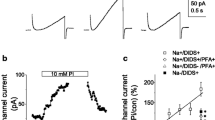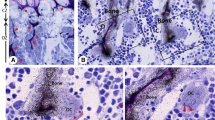Abstract
The culture of parietal bones from 4-day old mice in indomethacin (Ind) for 1 day caused a large reduction in the number of tartrate-resistant acid phosphatase positive osteoclasts (TRAP+OC) relative to both control bones and to freshly isolated bones. This reduction did not occur if prostaglandin E2 (PGE2) was present. When 5-bromo-2′-deoxyuridine (BDU) was injected into 4-day old mice, newly formed TRAP+OC nuclei became labeled 1 day later; these bones were then cultured with Ind for 1 day. TRAP+OC and newly labeled TRAP+OC nuclei were commensurately decreased in number. This suggests an active down-regulation rather than merely the inhibition of new TRAP+OC formation. Incubation of bones with Ind and either PGE2, parathyroid hormone, or 1,25 dihydroxyvitamin D3 for 6 hours following a 1-day preincubation in Ind, resulted in an increase in TRAP+OC compared with Ind alone. Using BDU labeling in vitro and in vivo, we show that this increase in number of TRAP+OC is not the result of cell proliferation, but rather differentiation of postmitotic precursors.
Similar content being viewed by others
References
Chambers TJ, Magnus CJ (1982) Calcitonin alters the behavior of isolated osteoclasts. J Pathol 136:27–33
Chambers TJ, Ali NN (1983) Inhibition of osteoclastic motility by prostaglandins I2E1,E2 and 6-oxoE1. J Pathol 139:383–397
Rodan GA, Martin TJ (1981) Role of osteoblasts in control of bone resorption—a hypothesis. Calcif Tissue Int 33:349–351
Chambers TJ, McSheehy PMJ, Thomson BM, Fuller K (1985) The effect of calcium-regulating hormones and prostaglandins on bone resorption by osteoclasts disaggregated from neonatal rabbit bones. Endocrinology 116:234–239
Thomson BM, Saklatvala J, Chambers TJ (1986) Osteoblasts mediate interleukin 1 stimulation of bone resorption by rat osteoclasts. J Exp Med 164:104–112
McSheehy PMJ, Chambers TJ (1986) Osteoblast-like cells in the presence of parathyroid hormone release soluble factor that stimulates osteoclastic bone resorption. Endocrinology 119: 1654–1659
Minkin C (1982) Bone acid phosphatase as a marker of osteoclast function. Calcif Tissue Int 34:285–290
Helfrich MH, Mieremet RHP, Thesingh CW (1989) Osteoclast formation in vitro from progenitor cells present in the adult mouse circulation. J Bone Miner Res 4:325–331
Hattersley G, Chambers TJ (1989) Generation of osteoclastic function in mouse bone marrow cultures: multinuclearity and tartrate-resistant acid phosphatase are unreliable markers for osteoclastic differentiation. Endocrinology 124:1689–1696
Modderman WE, Tuinenburg-Bol Raap AC, Nijweide PJ (1991) Tartrate-resistant acid phosphatase is not an exclusive marker for mouse osteoclasts in cell culture. Bone 12:81–87
Chambers TJ, Fuller K, Darby JA (1987) Hormonal regulation of acid phosphatase release by osteoclasts disaggregated from neonatal rat bone. J Cell Physiol 132:90–96
Zaidi M, Moonga B, Moss DW, MacIntyre I (1989) Inhibition of osteoclastic acid phosphatase abolishes bone resorption. Biochem Biophys Res Comm 159:68–71
Lerner UH (1987) Modification of the mouse calvarial technique improve responsiveness to stimulators of bone resorption. J Bone Miner Res 2:375–383
Shacter E, Lopez RL, Pati S (1991) The myeloperoxidase-H2O2-Cl system of neutrophils is inhibited by indomethacin and other non-steroidal anti-inflammatory drugs. Biochem Pharmacol 41:975–984
Klein DC, Raisz LG (1970) Prostaglandins: stimulation of bone resorption in tissue culture. Endocrinology 86:1436–1440
Thompson DD, Rodan GA (1988) Indomethacin inhibition of tenotomy-induced bone resorption in rats. J Bone Miner Res 3:409–414
Rifkin BR, Baker RL, Coleman SJ (1980) Effects of prostaglandin E2 on macrophages and osteoclasts in cultured fetal long bones. Cell Tissue Res 207:341–346
Akatsu T, Takahashi N, Debai K, Morita I, Murota S, Nagata N, Takatani O, Suda T (1989) Prostaglandins promote osteoclastlike cell formation by a mechanism involving cyclic adenosine 3′,5′-monophosphate in mouse bone marrow cell cultures. J Bone Miner Res 4:29–35
Collins DA, Chambers TJ (1991) Effect of prostaglandins E1, E2 and F2alpha on osteoclast formation in mouse bone marrow cultures. J Bone Miner Res 6:157–165
Collins DA, Chambers TJ (1992) Prostaglandin E2 promotes osteoclast formation in murine hematopoietic culture through an action on hematopoietic cells. J Bone Miner Res 7:555–561
Marshall MJ, Davie MWJ (1991) An immunocytochemical method for studying the kinetics of osteoclast nucleic on intact mouse parietal bone. Histochem J 23:402–408
Holt I, Davie MWJ, Braidman IP, Marshall MJ (1994) TRAP-positive osteoclasts in mouse parietal bones are acutely regulated by endogenous and exogenous prostaglandins. Bone (abstract) 15:238
Holt I, Davie MWJ, Braidman IP, Marshall MJ (1994) IL-6 is produced by PGE2-stimulated neonatal mouse parietal bone cultures but it does not cause the resulting osteoclast differentiation or bone resorption. Bone (abstract) 15:455
Holt I, Davie MWJ, Braidman IP, Marshall MJ (1994) Interleukin-6 does not mediate the stimulation by prostaglandin E2, parathyroid hormone or 1,25 dihydroxyvitamin D3 of osteoclast differentiation and bone resorption in neonatal mouse parietal bones. Calcif Tissue Int 55:114–119
Marshall MJ, Holt I, Davie MWJ (1993) Osteoclast recruitment in mice is stimulated by (3-amino-1-hydroxypropylidene)-1,1-bisphosphonate. Calcif Tissue Int 52:21–25
Lorenzo JA, Quinton J, Sousa S, Raisz LG (1986) Effects of DNA and prostaglandin synthesis inhibitors on the stimulation of bone resorption by epidermal growth factor in fetal rat long-bone cultures. J Clin Invest 77:1897–1902
Abe K, Ohno K, Hasegawa K (1990) Morphological relationships between osteoclasts and bone resorption surfaces on mouse parietal bones. Arch Histol Cytol 53:95–102
Young RW (1962) Cell proliferation and specialization during endochondral osteogenesis in young rats. J Cell Biol 14:357–370
Rasmussen H, Bordier P (1974) The physiological and cellular basis of metabolic bone disease. Williams and Wilkins Co., Baltimore, pp 35–70
Zambonin Zallone A, Teti A (1981) The osteoclasts of hen medullary bone under hypocalcaemic conditions. Anat Embryol 162:379–392
Adachi K, Chole RA, Yee J (1991) Indomethacin inhibition of middle ear bone resorption. Arch Otolaryngol Head Neck Surg 117:267–269
Arita K, Kato K, Tojo T, Nishino M (1989) Studies on factors causing tooth resorption. 1. Role of prostaglandins as a chemical mediator on resorption of deciduous teeth in rabbits. Jpn J Pedodont 27:621–628
Author information
Authors and Affiliations
Additional information
This work has been presented in part as an abstract to the Bone and Tooth Society Summer meeting, July 1993
Rights and permissions
About this article
Cite this article
Marshall, M.J., Holt, I. & Davie, M.W.J. The number of tartrate-resistant acid phosphatase-positive osteoclasts on neonatal mouse parietal bones is decreased when prostaglandin synthesis is inhibited and increased in response to prostaglandin E2, parathyroid hormone, and 1,25 dihydroxyvitamin D3 . Calcif Tissue Int 56, 240–245 (1995). https://doi.org/10.1007/BF00298618
Received:
Accepted:
Issue Date:
DOI: https://doi.org/10.1007/BF00298618




